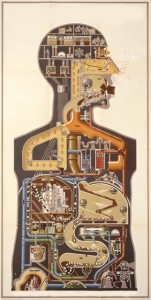 1- THE BODY IS A MACHINE
1- THE BODY IS A MACHINE
Just like a car the body is a machine designed to work in a specific fashion.
Nothing in the body works in isolation—every part has an explicit function meant to work in harmony with other parts.
Our skeleton is like the chassis of a car and the quality of our posture determines whether all of the moveable parts can work effectively.
Many of the body’s muscles though far away from each other are meant to work in synch and require proper posture to do so.
Our body follows a mechanical model—it is a series of arches, hinges, and pulleys, and learning about and understanding your body’s mechanics will allow you to effectively utilize the genius behind the body’s design.
2- OPERATING INSTRUCTIONS
You have to learn how the body works in order to use it correctly.
A question I am often asked is—Don’t we just know how to walk?
There are so many things we teach babies and young children— how to eat with a fork and spoon, how to tie your shoes and zip a jacket, but when it comes to walking, we all take our first step somewhere between ten and eighteen months old, get a big clap and a cheer from our parents and are then left to our own devices.
The fact is we are designed to walk in a specific way.
Bones hold us up; muscles move us; nerves tell the muscles to move the bones.
The foot is meant to fall very near to parallel with a distance of two or so inches between each foot.
Our arms are meant to move in opposition to the legs with each step—when the left leg moves forward the right arm should move the same distance at the same pace. Our head is meant to be level so that the eyes can best communicate with the spine.
3-BATTERIES NOT INCLUDED
Some people are born strong. Look at your ancestry. Where did you come from?
If your forefathers were strong like mine, you likely have a reserve of strength stored away in your DNA.
Our level of childhood activity goes a long way to determining the strength you carry into adulthood as well. An active child who played a lot of sports or just ran around a great deal will have a lot more core strength and body awareness than someone who spent more time indoors and avoided the playing field.
There are many mitigating factors to movement as well, including illnesses, accidents, and traumas both physical and emotional.
Core Power is a very popular cultural buzz phrase.
My approach to the core is about creating strength to support the muscles and bones of walking. Without the proper tone in the muscles of the pelvis and trunk, the body is a machine that is not free to move effectively.
Our society’s aesthetic focus is on the surface and the extremities.
When most people go to the gym they work the muscles that people can see—they build strength in the arms legs and the surface of the belly.
While tone in these muscles might look good, if it is pursued at the expense of the muscles responsible for holding us up and moving us we will run into trouble in the long run.
The muscles of the inner thigh, the pelvic floor, and deep low belly are the key core muscles for the FitzGordon Method.
These three groups of muscles tend to be weak dues to imbalances with their opposite more external counterparts.
Pay attention to your mechanics and learn which muscles need building for a more finely tuned and balanced body. The body is a machine that likes to function efficiently but you have to show it the way how.
